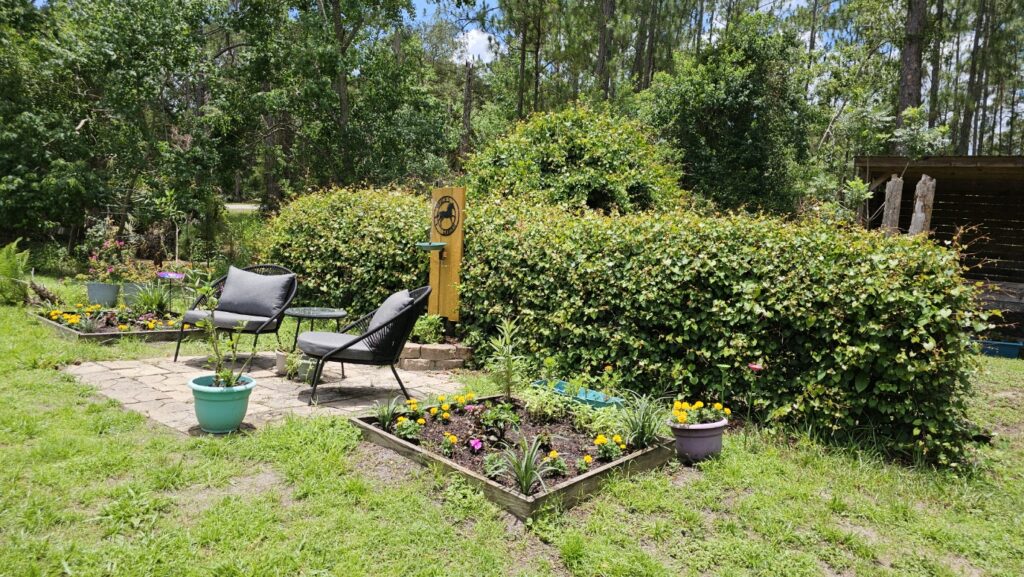
Welcome Frogs, Toads, and Lizards to Your Backyard Habitat
How to Create a Safe, Natural Habitat for Frogs, Toads and Lizards in Your Own Backyard
Frogs, toads, and lizards aren’t just fascinating to watch—they’re essential parts of a thriving, balanced ecosystem. These small creatures play a big role in keeping insect populations in check and are indicators of a healthy, chemical-free environment. Whether you’re building a pollinator garden, wildlife oasis, or just love hearing their nighttime songs, here’s how to invite these charming guests into your backyard habitat.
Why They Matter
- Pest Control Pros: They eat mosquitoes, beetles, flies, slugs, and other garden pests.
- Ecosystem Indicators: Amphibians are sensitive to pollution, so their presence suggests your space is safe and clean.
- Wildlife Allies: They play a crucial role in the food web and are natural neighbors to birds, snakes, and mammals.
Habitat Must-Haves
🌧️ Water
- Frogs especially need water for breeding.
- Use a shallow bowl, mini pond, or solar fountain.
- Keep water fresh and change it regularly.
🌳 Shelter
- Provide shade and cover using:
- Logs
- Rocks
- Clay pots turned on their sides
- Purpose-built toad or reptile houses (like small resin hides or tree-stump decor)
- Tuck shelters near moist areas or under bushes.
We chose a small tree-stump toad house to tuck under the vines on our fence. It blends in beautifully and provides a safe, shaded space for frogs and toads to return.
➤ Here’s the one we’re using if you’d like to add a little something to your own habitat too.
When our beloved horse Gracie was with us, frogs and toads made their home under her trough. They’d burrow into the sand and rest in the shade she unknowingly provided. When it was time to clean the trough, I was always so afraid we’d hurt them, so we’d carefully lift it up and relocate them temporarily. Once we were done, we’d bring them back and they’d settle into the little air pockets beneath it—back home again.
It offered the shelter and moisture they loved, but I wonder if they also enjoyed the sound of Gracie drinking, or something else about her being there because after she passed, they went away. Now, we’re rebuilding a little habitat for them—hoping to welcome them back once more.
☕ Moisture & Mulch
- Frogs and toads need damp environments.
- Use leaf litter, pine needles, or natural mulch to retain ground moisture.
- Avoid overly dry or hot, exposed areas.
💪 Pesticide-Free Zone
- Do not use pesticides, herbicides, or chemical fertilizers.
- Amphibians breathe and absorb moisture through their skin—they’re very sensitive to toxins.
Creating a Frog- and Toad-Friendly Garden Layout
- Shaded corners with damp mulch = perfect for hiding.
- Low water bowls in a quiet spot = essential hydration.
- Under-vine or under-bush shelters = natural camouflage and safety.
- Small decorative houses like the tree-stump resin hide are great additions that blend in beautifully.
Listening for Success
You may never see all your new visitors, but you’ll often hear them! Frogs and toads call during the evening and night. If you’re hearing croaks, chirps, or trills under your hedges or near your fence, that’s a sign you’ve built a welcoming space.
Don’t Forget the Lizards!
- Lizards love warm stone surfaces and vertical hiding spots.
- Include sunny areas with low ground cover for hunting and basking.
- Stack a few flat stones or repurpose old bricks into a hideaway “lizard lounge.”
Safety and Coexistence Tips
- Avoid picking up amphibians or reptiles—observe respectfully.
- Keep dogs and cats out of their zones when possible.
- Always rinse new toad houses or hides before placing outdoors.
Local Ordinance Reminder
While frogs, toads, and lizards are generally safe to attract, be sure to check local ordinances or consult with your regional wildlife agency before making habitat changes. Some areas may have restrictions related to feeding wildlife or landscaping features that unintentionally attract protected species. When in doubt, reach out to your local municipality or state wildlife office.
By welcoming frogs, toads, and lizards into your garden, you’re doing more than just building a backyard habitat. You’re restoring balance, reducing pests, and creating a peaceful, thriving ecosystem—one hop at a time.
This post is part of our BearBunk Backyard Habitat Series. Explore more on pollinators, water features, and natural gardening on the Habitat tab!
Let’s make our outdoor spaces croak, chirp, buzz, flutter, and thrive — one backyard at a time. 🌸🐝
More from the Backyard Habitat Series:
Stay tuned for more DIY tips, habitat upgrades, and ways to support the wild ones who share our world. 🐾🌿
Backyard Wildlife Watching Guide: How to Spot Animals in Your Own Backyard
Wildlife Friendly Backyard Habitat Backyard Wildlife Watching Guide If you’re building a wildlife-friendly backyard, one…
How We Set Up Our Backyard Bee House for Native Pollinators
Preview in new tab Wildlife Friendly Backyard Habitat 🐝 Welcoming Bees to Our Backyard: Unboxing…
Welcome Frogs, Toads, and Lizards to Your Backyard Habitat
Wildlife Friendly Backyard Habitat How to Create a Safe, Natural Habitat for Frogs, Toads and…
Gracie’s Garden: Our Almost-Ready Pollinator Paradise
Wildlife Friendly Backyard Habitat Want to attract more bees, butterflies, and hummingbirds to your yard?…
Wildlife Shelter 101: How to Create Safe Spaces in Your Backyard
Wildlife Friendly Backyard Habitat Creating Safe Spaces in Your Backyard Building a wildlife-friendly backyard is…
Turn Your Backyard into a Pollinator Paradise: 5 Essentials to Get Started
Wildlife Friendly Backyard Habitat Want to attract more bees, butterflies, and hummingbirds to your yard?…
Affiliate Disclosure
BearBunk may earn a small commission from purchases made through Amazon affiliate links, at no extra cost to you. Thank you for helping us help animals thrive.






Leave a Reply